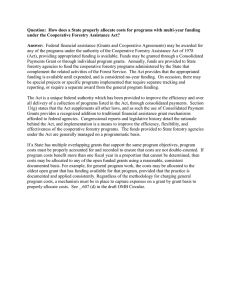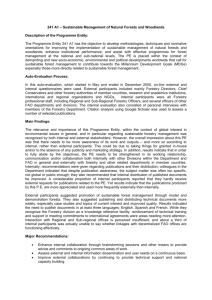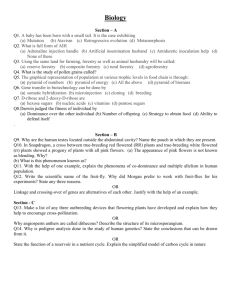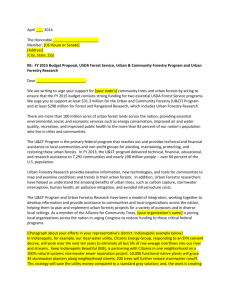Document 11117871
advertisement
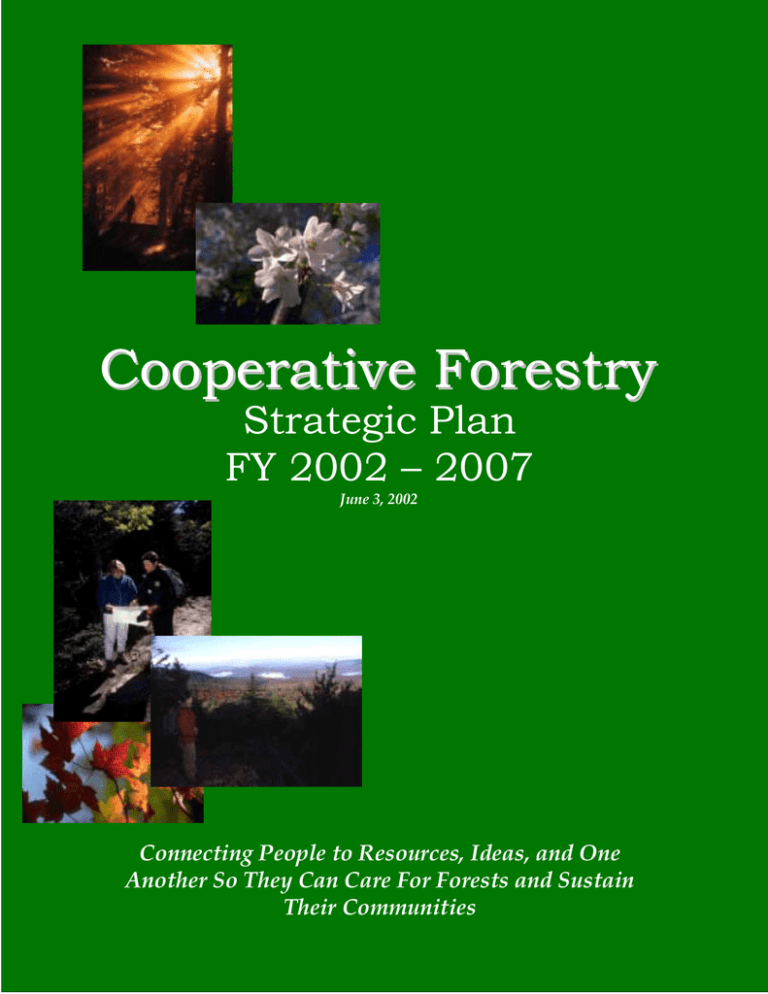
Connecting People to Resources, Ideas, and One Another So They Can Care For Forests and Sustain Their Communities. Cooperative Forestry Strategic Plan FY 2002 – 2007 June 3, 2002 Connecting People to Resources, Ideas, and One Another So They Can Care For Forests and Sustain Their Communities Cooperative Forestry 0 SUSTAINING NATURAL RESOURCES AND COMMUNITIES A STRATEGIC PLAN FOR COOPERATIVE FORESTRY FY 2002-2007 I. INTRODUCTION II. A VISION FOR THE FUTURE Forestland is one of the largest land cover categories in the United States. Private, state, tribal, and community forest owners manage 490 million acres or two-thirds of the Nation's forests. These non-federal forests and their owners contribute to the quality of life for millions of Americans, and are under increasing pressure to provide forest products, water, fish and wildlife habitat, livable open space, and recreation opportunities. The vision for Cooperative Forestry is simple in words and yet profound in its implications: “Sustainable Natural Resources and Communities.” Stewardship of the Nation’s forests and assistance to communities requires longterm commitment and collaborative effort. Sustainability contains social, economic, and environmental components that need to be integrated when developing alternatives and solutions. Creating sustainable approaches requires informed decisions using the best available science. The Forest Service provides assistance and support to these landowners through Cooperative Forestry, which is part of the State and Private Forestry mission area. Cooperative Forestry also provides a link across land ownerships and landscapes, including the 191 million acres of public forests and grasslands managed by the National Forest System. Knowledge and skills in land use, resource management, and community capacity building are essential if landowners and communities are to develop sustainable solutions at a landscape scale. Landowners and communities that monitor and document the results of their actions, and that regularly reflect on progress and barriers, learn from that experience. They become more resilient and better able to sustain themselves over time. The social, economic, and environmental contributions forests make to the greater societal good are often poorly understood or appreciated. This is especially true in a rapidly urbanizing society increasingly disconnected from its dependence on natural resources. Thus it is important the Forest Service provide leadership for sustainability of natural resources across private and public ownerships and help bridge the knowledge and attitude gaps between rural and urban America. III. COOPERATIVE FORESTRY’S MISSION Cooperative Forestry’s mission is: “Connecting people to resources, ideas, and one another so they can care for forests and sustain their communities.” Within the Forest Service, Cooperative Forestry is unique in helping to bridge these gaps as its programs are delivered primarily with other partners such as state forestry agencies, communities, non-governmental, educational and research organizations. Cooperative Forestry supports the Forest Service mission in two ways. First, it helps meet the needs of present and future generations by “connecting people to 1 resources and ideas” and assisting them to “sustain their communities.” Second, it sustains the health, diversity, and productivity of the Nation’s forests by helping people care for their land and resources. U.S. DEPARTMENT OF AGRICULTURE MISSION “Enhance the quality of life for the American people by supporting production of agriculture: • • • • • Cooperative Forestry’s distinct contribution to the mission of the U.S. Department of Agriculture is assisting landowners and communities in caring for their forests and solving their own problems. Cooperative Forestry and USDA mutually support sustainable development in communities, care of forestlands and grasslands, and the expansion of markets for forest-based products and services. ensuring a safe, affordable, nutritious, and accessible food supply; caring for agricultural, forest, and range land; supporting sound development of rural communities; providing economic opportunities for farm and rural residents; and expanding global markets for agricultural and forest products and services and working to reduce hunger in America and throughout the world.” Alignment of all three missions is crucial for Cooperative Forestry success in contributing to the overall missions and goals of the Forest Service and USDA. IV. COOPERATIVE FORESTRY GOALS Three goals assist Cooperative Forestry in fulfilling its vision and mission. These goals can also be thought of as desired future conditions or outcomes of Cooperative Forestry efforts. U.S.D.A. FOREST SERVICE MISSION “To sustain the health, diversity and productivity of the nation’s forests and grasslands to meet the needs of present and future generations.” 1. Strengthened Relationships and Communication. Active outreach, and information sharing among landowners, organizations, enterprises, and agencies lead to collaborative ventures no one person or group could do alone. 2. Sustainable Natural Resources With Multiple Benefits. Stewardship of natural resources by landowners and communities sustains individuals, families, enterprises and communities over the long term by providing such benefits as clean water, biodiversity, and healthy ecosystems. COOPERATIVE FORESTRY’S MISSION “Connecting people to resources, ideas, and one another so they can care for forests and sustain their communities.” 3. Diverse and Healthy Economies. A diverse economic base helps maintain services, businesses, and households when the economy fluctuates. 2 V. COOPERATIVE FORESTRY – STRATEGIES TO ACHIEVE GOALS • Networking and Information Sharing. A key part of Cooperative Forestry’s program delivery is networking and information sharing. This is integral to the mission of “connecting people to resources, ideas, and one another …”, through developing “train the trainer” opportunities, encouraging “peer to peer” learning, or supporting the formation of landowner cooperatives. • Outreach to New and NonTraditional Audiences. Cooperative Forestry programs will be inclusive of diverse and underserved audiences when delivered at any level. We will continually reach out to new landowners and communities. Cooperative Forestry will employ these strategies in the operation and delivery of its programs: • • • • Best Business Practices. Progress toward the goals cannot be achieved in a short period of time. Short-term and long-term actions, indicators, and measures will be developed to ensure goals and outcomes are being achieved. Collaborative Landscape Level Approaches. Collaborative landscape level approaches will be emphasized when working with landowners and communities to address natural resource related issues and opportunities. Social, economic, and environmental dimensions will be integrated when crafting solutions. Our efforts will be integrated with other Forest Service programs and those of other federal, state, tribal, and nongovernmental entities. VI. CONCLUSION Leading Edge Technical Assistance and Technology. Cooperative Forestry will concentrate its efforts in assisting landowners and communities to acquire the knowledge and skills needed to make informed decisions based on the best-available science. We will use the latest and most cost-efficient and effective web-based communications and geographic information systems technologies. Cooperative Forestry’s unique strength and advantage is that it provides for coordinated citizen-based sustainable solutions tailored to address the varied local dimensions of natural resource issues. The result of Cooperative Forestry achieving its mission will be landowners, communities, states, and tribes with the capacity to identify and achieve their desired futures. Cooperative Forestry works with diverse delivery partners, each with its own unique mission and priorities and each needing to respond to their own land and forest conditions, and political and citizen expectations. Capacity Building. People are the basis for success in sustaining natural resources and communities. The focus of Cooperative Forestry programs is to build the capacity of landowners, communities, states, and tribes to solve their own problems and capitalize on their opportunities. End Note: This strategic plan is a living document. It has been, and will be, revised as needs arise. 3

